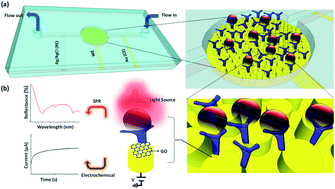Our official English website, www.x-mol.net, welcomes your
feedback! (Note: you will need to create a separate account there.)
Integrated dual-modality microfluidic sensor for biomarker detection using lithographic plasmonic crystal†
Lab on a Chip ( IF 6.1 ) Pub Date : 2018-02-08 00:00:00 , DOI: 10.1039/c7lc01211j Md. Azahar Ali 1, 2, 3, 4 , Shawana Tabassum 1, 2, 3, 4 , Qiugu Wang 1, 2, 3, 4 , Yifei Wang 1, 2, 3, 4 , Ratnesh Kumar 1, 2, 3, 4 , Liang Dong 1, 2, 3, 4
Lab on a Chip ( IF 6.1 ) Pub Date : 2018-02-08 00:00:00 , DOI: 10.1039/c7lc01211j Md. Azahar Ali 1, 2, 3, 4 , Shawana Tabassum 1, 2, 3, 4 , Qiugu Wang 1, 2, 3, 4 , Yifei Wang 1, 2, 3, 4 , Ratnesh Kumar 1, 2, 3, 4 , Liang Dong 1, 2, 3, 4
Affiliation

|
This paper reports an integrated dual-modality microfluidic sensor chip, consisting of a patterned periodic array of nanoposts coated with gold (Au) and graphene oxide (GO), to detect target biomarker molecules in a limited sample volume. The device generates both electrochemical and surface plasmon resonance (SPR) signals from a single sensing area of Au–GO nanoposts. The Au–GO nanoposts are functionalized with specific receptor molecules, serving as a spatially well-defined nanostructured working electrode for electrochemical sensing, as well as a nanostructured plasmonic crystal for SPR-based sensing via the excitation of surface plasmon polaritons. High sensitivity of the electrochemical measurement originates from the presence of the nanoposts on the surface of the working electrode where radial diffusion of redox species occurs. Complementarily, the SPR detection allows convenient tracking of dynamic antigen–antibody interactions, to describe the association and dissociation phases occurring at the sensor surface. The soft-lithographically formed nanoposts provide high reproducibility of the sensor response to epidermal growth factor receptor (ErbB2) molecules even at a femtomolar level. Sensitivities of the electrochemical measurements to ErbB2 are found to be 20.47 μA μM−1 cm−2 in a range from 1 fM to 0.1 μM, and those of the SPR measurements to be 1.35 nm μM−1 in a range from 10 pM to 1 nM, and 0.80 nm μM−1 in a range from 1 nM to 0.1 μM. The integrated dual-modality sensor offers higher sensitivity (through higher surface area and diffusions from nanoposts for electrochemical measurements), as well as the dynamic measurements of antigen–antibody bindings (through the SPR measurement), while operating simultaneously in a same sensing area using the same sample volume.
中文翻译:

集成双模态微流控传感器,用于使用光刻等离激元晶体进行生物标记检测†
本文报道了一种集成的双模态微流控传感器芯片,该芯片由图案化的周期性周期性阵列组成,这些阵列的纳米柱涂有金(Au)和氧化石墨烯(GO),可在有限的样品量中检测目标生物标志物分子。该设备从Au-GO纳米柱的单个感应区域生成电化学和表面等离振子共振(SPR)信号。Au-GO纳米柱可通过特定的受体分子进行功能化,可作为空间精确定义的纳米结构化工作电极,用于电化学传感,以及纳米结构的等离激元晶体,可用于通过SPR进行传感表面等离子体激元极化子的激发。电化学测量的高灵敏度源自工作电极表面上纳米柱的存在,在纳米柱中发生氧化还原物质的径向扩散。作为补充,SPR检测可以方便地跟踪动态抗原-抗体相互作用,以描述传感器表面发生的缔合和解离阶段。软光刻形成的纳米柱即使在飞摩尔水平,也能提供对表皮生长因子受体(ErbB2)分子的传感器响应的高重现性。电化学测量对ErbB2的灵敏度为20.47μAμM -1 cm -2在从1 FM至0.1μm的范围内,并且那些SPR测定的是1.35纳米μM -1的范围从下午10点至1nM,和0.80纳米μM -1在从1nM至0.1μM的范围内。集成的双模态传感器提供更高的灵敏度(通过更大的表面积和纳米柱的扩散进行电化学测量),以及抗原-抗体结合的动态测量(通过SPR测量),同时使用相同的样品量。
更新日期:2018-02-08
中文翻译:

集成双模态微流控传感器,用于使用光刻等离激元晶体进行生物标记检测†
本文报道了一种集成的双模态微流控传感器芯片,该芯片由图案化的周期性周期性阵列组成,这些阵列的纳米柱涂有金(Au)和氧化石墨烯(GO),可在有限的样品量中检测目标生物标志物分子。该设备从Au-GO纳米柱的单个感应区域生成电化学和表面等离振子共振(SPR)信号。Au-GO纳米柱可通过特定的受体分子进行功能化,可作为空间精确定义的纳米结构化工作电极,用于电化学传感,以及纳米结构的等离激元晶体,可用于通过SPR进行传感表面等离子体激元极化子的激发。电化学测量的高灵敏度源自工作电极表面上纳米柱的存在,在纳米柱中发生氧化还原物质的径向扩散。作为补充,SPR检测可以方便地跟踪动态抗原-抗体相互作用,以描述传感器表面发生的缔合和解离阶段。软光刻形成的纳米柱即使在飞摩尔水平,也能提供对表皮生长因子受体(ErbB2)分子的传感器响应的高重现性。电化学测量对ErbB2的灵敏度为20.47μAμM -1 cm -2在从1 FM至0.1μm的范围内,并且那些SPR测定的是1.35纳米μM -1的范围从下午10点至1nM,和0.80纳米μM -1在从1nM至0.1μM的范围内。集成的双模态传感器提供更高的灵敏度(通过更大的表面积和纳米柱的扩散进行电化学测量),以及抗原-抗体结合的动态测量(通过SPR测量),同时使用相同的样品量。











































 京公网安备 11010802027423号
京公网安备 11010802027423号